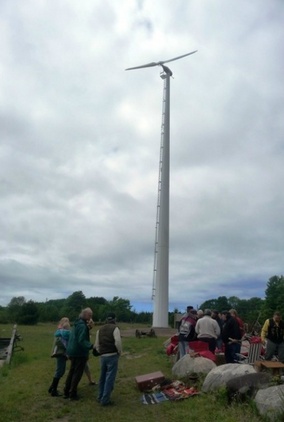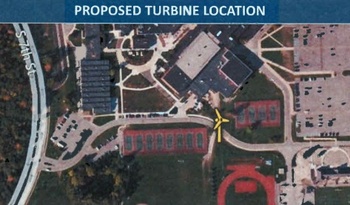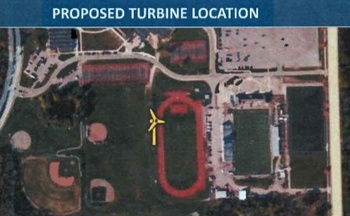Pioneer High School could be the future site of two towering wind turbines in Ann Arbor, according to city records obtained by AnnArbor.com under the Freedom of Information Act.
The city's proposed $1.4 million wind energy project in partnership with Ann Arbor Public Schools has been debated since it entered the public spotlight a few months ago.
But that debate largely has taken place without the general public knowing exactly where the turbines might go, or exactly how much energy they might produce.

One of two wind turbines proposed in Ann Arbor would be the same as this Gaia 11-kW turbine in Cross Village.
Courtesy of Lake Effect Energy Corp.
AnnArbor.com obtained 16 pages of previously unreleased documents on Thursday, including the project budget the city submitted to the U.S. Department of Energy, and wind study data for two proposed sites at Pioneer High.
The studies were done by New York-based Wind Products Inc.
According to the wind study data, the potential net energy savings from both turbines combined over 20 years is a little less than $130,000.
The city is planning to partner with AAPS and Wind Products Inc. to potentially install two turbines — both atop 120-foot monopoles — on school property.
The total budget for the project is shown at $1.44 million, which includes $556,571 for equipment, $830,797 in contractual costs, and lesser amounts for worker wages, benefits and travel.
The Ann Arbor City Council voted 10-0 in January to accept and appropriate up to $951,500 in federal grant money from the U.S. Department of Energy for the project.
The federal grant requires a $484,390 local match, but city officials have found a way around making a cash contribution. The city intends to partner with AAPS and Wind Products Inc. to provide the site and financing required for the match, so the city's contribution would be $18,590 in staff time.
It's expected the developer would construct the turbines and provide the public schools with a 20-year power purchase agreement that would help AAPS save on electricity costs.
Brian Steglitz, a senior utilities engineer for the city, has stated for months an exact location for the turbines hasn't been determined. Steglitz couldn't be reached to comment on the records showing two locations at Pioneer High were proposed months ago.
When asked at January's council meeting where the turbines might go, Steglitz told council members the school system specifically asked not to make the possible sites publicly available just yet.
Ann Arbor Public Schools Communications Director Liz Margolis said the district’s primary interest is the steady revenue stream the turbine project will bring in and the hands-on educational opportunities it can provide in the areas of science and technology.
The city is expected to lease the property for the wind turbine project from AAPS for a cost totaling about $2,000 per year, Margolis said.
“It’s a small amount, but we’ll take anything small we can get these day,” she said.

The records show the first wind turbine — an 11-kW Gaia turbine — proposed in a location just north of Pioneer High's outdoor track and east of the tennis courts.
Wind Analytics
The records show the first wind turbine — an 11-kW Gaia turbine — proposed in a location just north of Pioneer High's outdoor track and east of the tennis courts. A measure of the wind energy resource for the site determined an average wind speed of 9.5 mph.
With a 44-foot rotor diameter, the annual guaranteed production from the turbine is listed at 17,485 kWh per year.
Depending on the lease option chosen, the net energy savings over 20 years is shown ranging from $16,786 to $28,550.
The records show the second wind turbine — a 54.8-kW Endurance turbine — proposed in a location just south of the first one, along the western side of the outdoor track. A measure of the wind energy resource for the site determined an average wind speed of 9.3 mph.
With a 63-foot rotor diameter, the annual guaranteed production from the turbine is listed at 66,545 kWh per year.
Depending on the lease option chosen, the net energy savings over 20 years is shown ranging from $60,359 to $100,786.

The records show the second wind turbine — a 54.8-kW Endurance turbine — proposed in a location just south of the first one, along the western side of the outdoor track.
Wind Analytics
In 2011, the average Michigan household consumed 8,196 kWh of energy, according to the U.S. Energy Information Administration. That means the annual guaranteed production of the two turbines — 84,030 kWh — might be enough to offset the energy use and carbon emissions of 10 households.
Records show maintenance and repairs of both turbines would be the responsibility of Wind Products Inc., which would warranty all equipment and workmanship for the term of the lease.
The wind energy project requires relatively little involvement from AAPS, Margolis said, and it gets to participate in a local environmental initiative that benefits students and teachers.
“It’s a great opportunity to learn about wind and the powers of wind,” Margolis said.
Steglitz said last week the project still is in its infancy and the city is trying to develop agreements with the stakeholders involved before entering the next phase of work.
Once the agreements are in place and approved by the City Council, the project budget shows a $236,110 site analysis and an environmental impact study would follow.
Following that would be an outreach and education phase expected to cost $320,443, and then $140,999 for wind generator selection and procurement, and $724,033 for installation.
Margolis said she is not sure how far along the city’s wind energy project is at the moment, but she expects the district and the city will send out a notification to residents in the Pioneer area and allow them the opportunity to weigh in on the project.
Joe Woods, managing director of an Ohio-based wind energy company that has studied wind speeds in Washtenaw County, argued last week the $1.4 million project is a waste of taxpayer money.
The purpose of the project is to demonstrate the viability of wind energy technology and use it as an educational tool for the community and the schools. Project officials have said people seem to be misunderstanding the project — it isn't about setting up a commercially viable wind farm.
"I don't think that we are, as a city, indicating that we think Ann Arbor has this great wind resource and we want to tap into it," Steglitz told the City Council in January.
"What this is really about is educating the community about renewable sources of energy. And to have a wind turbine in the city, which is sort of a monument to renewable energy, sort of speaks a little bit to the community's goals and interests."
K-12 education reporter Danielle Arndt contributed to this report.
Ryan J. Stanton covers government and politics for AnnArbor.com. Reach him at ryanstanton@annarbor.com or 734-623-2529. You also can follow him on Twitter or subscribe to AnnArbor.com's email newsletters.